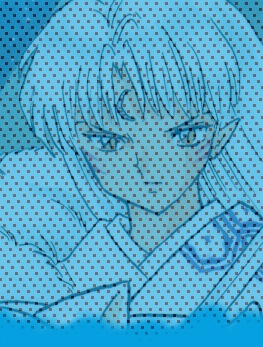
About the Manga
Inuyasha began serialization in 1996. Throughout the 1990's and into the 2000's sales of weekly manga magazines fell in Japan, Weekly Shonen Sunday often found itself falling into third place among shonen manga magazines, behind the dominant Weekly Shonen Jump and sometimes Shonen Magazine.
| Weekly Serializations in Shonen Sunday (少年サンデー) |
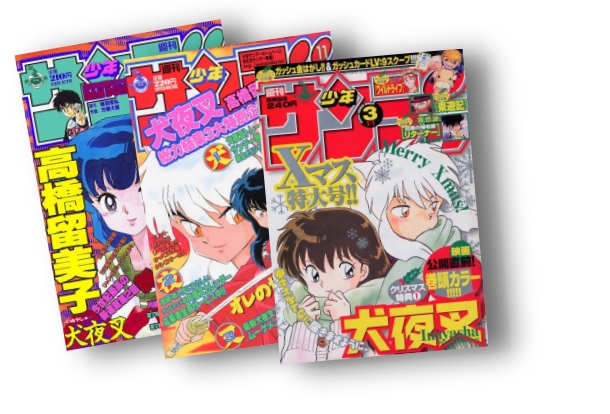 Rumiko Takahashi has published her work in Shonen Sunday since the beginning of her career in the late 1970s. Inuyasha was first published in Shonen Sunday 1996 Vol. 50. Urusei Yatsura and Ranma 1/2 both ran in this weekly magazine during the 1980s and 1990s. Takahashi also regularly publishes her work in other Shogakukan owned magazines such as Big Comic Spirits (Maison Ikkoku) and Young Sunday (One-Pound Gospel).
Rumiko Takahashi has published her work in Shonen Sunday since the beginning of her career in the late 1970s. Inuyasha was first published in Shonen Sunday 1996 Vol. 50. Urusei Yatsura and Ranma 1/2 both ran in this weekly magazine during the 1980s and 1990s. Takahashi also regularly publishes her work in other Shogakukan owned magazines such as Big Comic Spirits (Maison Ikkoku) and Young Sunday (One-Pound Gospel).
Each week, approximately 18 pages are published each week per Inuyasha chapter. Up to 21 other manga stories are published each week alongside Inuyasha, some of the most notable that ran concurrently were Detective Conan by Gosho Aoyama, Katsu by Mitsuru Adachi, Midori no Hibi by Kazurou Inoue and Cheeky Angel by Hiroyuki Nishimori. Each week a different artist is commissioned to do the cover and the first few pages which are done in color. With the exception of artbooks, these color pages are usually never reprinted. During Inuyasha publication Takahashi was still painting her color artwork with watercolor and stated that she did not own a computer. After the end of Inuyasha she would occasionally use digital color sparingly in subsequent series. |
| Tankobon (単行本) |
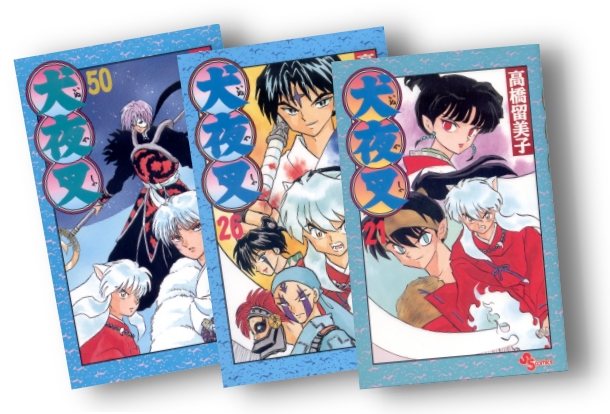 A few months after a title has been published in Shonen Sunday, they are collected into a small graphic novel called a tankobon). As a series gets older it is sometimes collected into other formats such as wideban, bunkoban, or shinsoban formats. The tankobon is the traditional format in which most all Japanese manga is published. Each volume contains about ten chapters. The entire series of Inuyasha consists of 56 tankobon volumes.
A few months after a title has been published in Shonen Sunday, they are collected into a small graphic novel called a tankobon). As a series gets older it is sometimes collected into other formats such as wideban, bunkoban, or shinsoban formats. The tankobon is the traditional format in which most all Japanese manga is published. Each volume contains about ten chapters. The entire series of Inuyasha consists of 56 tankobon volumes.
Shonen Sunday tankobon are all printed in the Japanese B6 format (12.8 cm × 18.2 cm or 5.04 in × 7.17 in). |
| Wideban (ワイド版) |
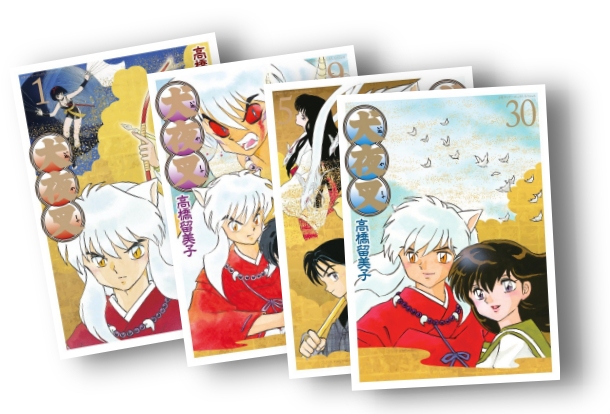 In 2013 in celebration of Rumiko Takahashi's 35th anniversary as a professional mangaka, Shogakukan began to re-release Inuyasha in wideban format. Upon the wideban's initial release, fans who committed to preordering the entire 30 volume set would receive a drama CD featuring a new story about the characters performed by the original anime voice actors. The audio drama deals with Inuyasha and Kagome's marriage, Sesshomaru's feeling for Rin, and everyone traveling to the afterlife to visit Inuyasha's father's grave.
In 2013 in celebration of Rumiko Takahashi's 35th anniversary as a professional mangaka, Shogakukan began to re-release Inuyasha in wideban format. Upon the wideban's initial release, fans who committed to preordering the entire 30 volume set would receive a drama CD featuring a new story about the characters performed by the original anime voice actors. The audio drama deals with Inuyasha and Kagome's marriage, Sesshomaru's feeling for Rin, and everyone traveling to the afterlife to visit Inuyasha's father's grave.
Additionally each wideban volume contains a new black and white illustration by Takahashi as well as a brief comment on the process of creating one of the characters or some other aspect of the epic series. We have collected these comments and illustrations which can be viewed in our Manga Extras section. |
| My First Big |
 One format that is aimed at a different market are the "My First Big" editions. These are found primarily in convenience stores across Japan like Lawson, Family Mart and 7-11. They are manga compilations somewhat similar to tankobon, only they use cheaper materials on newsprint stock identical to the paper type Shonen Sunday is printed on. Because of this they are not as expensive as usual editions, although they are of lesser quality (and thus do not age as well). These books are not made for the collector who wants to keep manga for posterity. They are made for the casual reader who may be looking to pick up a quick read. They are rarely ever sold outside Japan so you're unlikely to come across them unless you live there.
One format that is aimed at a different market are the "My First Big" editions. These are found primarily in convenience stores across Japan like Lawson, Family Mart and 7-11. They are manga compilations somewhat similar to tankobon, only they use cheaper materials on newsprint stock identical to the paper type Shonen Sunday is printed on. Because of this they are not as expensive as usual editions, although they are of lesser quality (and thus do not age as well). These books are not made for the collector who wants to keep manga for posterity. They are made for the casual reader who may be looking to pick up a quick read. They are rarely ever sold outside Japan so you're unlikely to come across them unless you live there.
|
| Art Books |
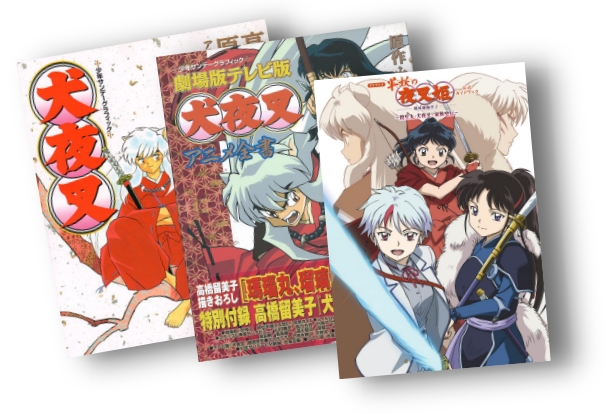 Inuyasha has had a number of artbooks focusing on both the manga and anime which goes to show the immense popularity of this series.
Inuyasha has had a number of artbooks focusing on both the manga and anime which goes to show the immense popularity of this series.
The first artbook, The Complete Collection of Original Drawings: The Anime World of Inuyasha (原画全集アニメ犬夜叉の世界/Genga Zenshū Anime Inuyasha no Sekai),collects the color artwork of Rumiko Takahashi without the titles and other writing the is overlaid when they are published in Shonen Sunday. This was published in English as The Art of Inuyasha: Anime Art Gallery and also as The Art of Inuyasha with a different cover (both from Viz). Despite the title there is very little anime-based content in this book, there are some early character designs and images up to approximately episode 15. Published in 2002 the second artbook, Movie and TV Edition: Inuyasha Anime Complete Works (劇場版テレビ版犬夜叉アニメ全書/Gekijo-ban Terebi-ban Inuyasha Anime Zensho), primarily features character designs from the anime series and voice actor interviews. Because this was published when the first film was released it focuses a great deal on the movie as well. It features an illustration of the villans from the first film done by Rumiko Takahashi herself, as well as more of her color manga illustrations. It also features set designs from the first film and many screen shots. The book also contains color manga artwork picking up from where the prior art book left off and continuing up to the Band of Seven color artwork. The third book, Inuyasha's Secrets: An Illustrated Compendium (犬夜叉奥義皆伝―図説大全/Inuyasha Ogi Kaiden Zusetsu Daisen) is almost completely black and white and deals with the characters of the manga series. It ranks their various stats and covers the basic storyline, characters, and demons appearing up to approximately volume 30 of the manga series. This was later published in English as Inuyasha Character Profiles. Released in 2021, this ultra-deluxe two volume collection is entitled Inuyasha Anime Settings Documents Collection (犬夜叉 アニメーション設定資料集/Inuyasha Animeshon Settei Shiryoushuu). These books collect color promotional artwork from the anime as well as hundreds of black and white design sheets of characters, items and locations. There are a number of interviews with the production staff of the anime included. Released in 2022, TV Animation "Yashahime" Official Guidebook: Sesshomaru Inuyasha Family History (TVアニメ『半妖の夜叉姫』公式ガイドブック: 殺生丸・犬夜叉 家族史伝/TV Anime "Yashahime" Koshiki Gaidobukku: Sesshomaru Inuyasha Kazoku Shiden) contains character designs as well as full-color promotional images that appeared in places like Newtype and Animage magazines to promote the first season of the series. Additionally it contains staff interviews, as well as an interview with Rumiko Takahashi discussing creating and designing the principle characters. A number of artbooks have also been released that feature all of Rumiko Takahashi's work and are not focused solely on one series. Of those: Rumiko Takahashi Exhibition - It's a Rumic World (高橋留美子展 It's a Rumic World/Takahashi Rumiko Ten It's a Rumic World) was published in 2007 and sold at the gallery exhibition of her work that ran in Japan from July 30th - August 11th of that year. It features color artwork from Urusei Yatsura, Maison Ikkoku, Ranma 1/2, Inuyasha, One-Pound Gospel, Mermaid Saga and a number of her short stories. One of the best overall overviews of Takahashi's career is Rumic World 35 which is a three volume boxset comprising All Star, Showtime and the collected children's manga MOON, The Great Pet King. The first two volumes mentioned contain character profiles, items, locations and color art for all of her series up to Kyokai no Rinne to celebrate 35th anniversary of her debut. |
| Anime Books (テレビアニメ版 ) |
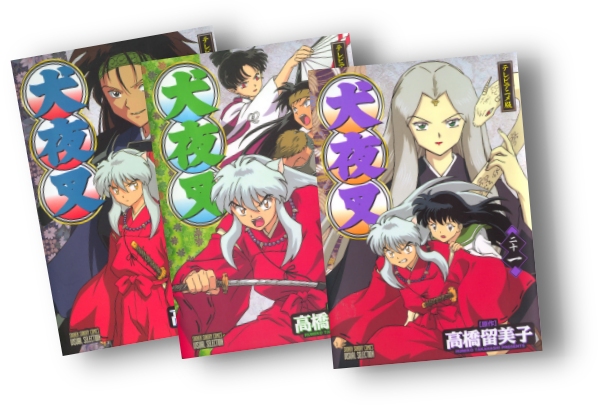 Extremely popular manga series get turned into anime, and extremely popular anime get turn back into manga. The anime book series is 30 volumes long and takes still images from episodes of the television series and captions them with speech balloons like a traditional comic book. Takahashi's only previous work to get this treatment was Urusei Yatsura, although Ranma 1/2 did recieve one volume in this format.
Extremely popular manga series get turned into anime, and extremely popular anime get turn back into manga. The anime book series is 30 volumes long and takes still images from episodes of the television series and captions them with speech balloons like a traditional comic book. Takahashi's only previous work to get this treatment was Urusei Yatsura, although Ranma 1/2 did recieve one volume in this format.
|
| Miscellaneous Books |
 Published at the conclusion of the manga, Inuyasha Special Edition: Inuyasha and Kagome (犬夜叉特別編集 犬夜叉とかごめ/Inuyasha Tokubetsu Henshuu Inuyasha to Kagome) collects some of the most important storylines in the relationship between Inuyasha and Kagome. Broken down into sections, the chapters covered are listed below. Coveted by many fans upon the manga's conclusion, who hoped for a few new pages of story and art, the book contains only reprints, nothing new.
Published at the conclusion of the manga, Inuyasha Special Edition: Inuyasha and Kagome (犬夜叉特別編集 犬夜叉とかごめ/Inuyasha Tokubetsu Henshuu Inuyasha to Kagome) collects some of the most important storylines in the relationship between Inuyasha and Kagome. Broken down into sections, the chapters covered are listed below. Coveted by many fans upon the manga's conclusion, who hoped for a few new pages of story and art, the book contains only reprints, nothing new.
On March 11, 2011 Japan was struck by the fifth most powerful earthquake ever recorded. To raise money for the victims mangaka Fujihiko Hosono developed the idea of Heroes Come Back (ヒーローズカムバック) in which manga artists would draw a new story featuring some of their most famous past creations with 100% of the proceeds from the collection going to the Tohoku earthquake relief efforts. The works included are:
The Inuyasha chapter, entitled "Since Then" takes place after the series finale. To read a complete summary, click here. Inuyasha: Secrets & Quiz Encyclopedia (犬夜叉ひみつ&クイズ百科/Inuyasha Himitsu & Kuizu Hyakka) is a 2002 book from the Korotan Bunko line of triva and activity books. This book features character profiles, puzzles and quizzes that range from simple to more challenging questions. Inuyasha Secret Retsuden!! (犬夜叉ひみつ烈伝!!/Inuyasha Himitsu Retsuden!!) is a book in a similar vein. The Inuyasha Novel (小説犬夜叉/Shosetsu Inuyasha) is a light novels which contains new illustrations by Rumiko Takahashi. This novelization of the Inuyasha series was written by Tomoko Konparu, who has also written novelizations of Takahashi's Urusei Yatsura and Mermaid Saga. Inuyasha: Secret of the Cursed Mask Guide Book (犬夜叉 呪詛の仮面ガイドブック/Inuyasha Koushi Gaido Bukku) is a strategy guide for the 2004 Playstation 2 roleplaying game. Released in 2000, Inuyasha: Thrilling Fan Book (犬夜叉 わくわくファンブック/Inuyasha Waku Waku Fan Bukku) this is a children's book that contains character profiles, quizzes, manga summaries, a catalog of goods and stickers. There are two oversized, thin format playbills that were released for the first Inuyasha stageplay. These are the Shinkansen Parcomics Inuyasha playbills which feature cast photographs from the show and images from the performance. The second book is Shinkansen Paracomics Inuyasha Vol. 2. On April 16, 2009 sheet music for wind instruments was released in a book titled Wind Instruments for Inuyasha (吹奏楽のための犬夜叉/Suisougaku no tame no Inuyasha). The book retailed for 3990 yen. |
| Foreign Editions |
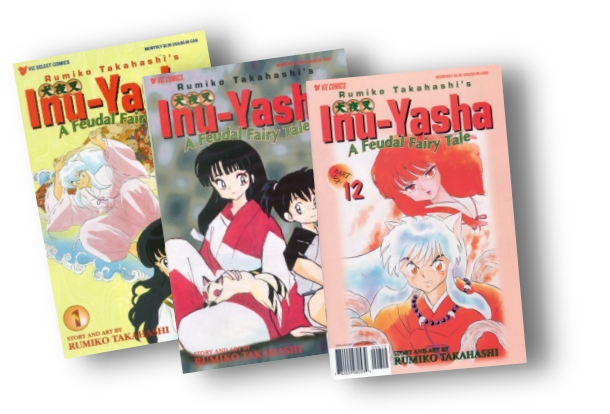 Outside of Japan Rumiko Takahashi has a very large following as well. Her biggest publisher outside of Japan is Viz Comics, which is owned by Shogakukan, Takahashi's Japanese publisher. Her works are also published in Latin America, throughout Asia, and are extremely popular in Western Europe. Shown here are Viz's comic book format issues that were released in the 1990s. At the time each comic book issue featured two chapters per month which made the series comic out half as fast as it did in Japan.
Outside of Japan Rumiko Takahashi has a very large following as well. Her biggest publisher outside of Japan is Viz Comics, which is owned by Shogakukan, Takahashi's Japanese publisher. Her works are also published in Latin America, throughout Asia, and are extremely popular in Western Europe. Shown here are Viz's comic book format issues that were released in the 1990s. At the time each comic book issue featured two chapters per month which made the series comic out half as fast as it did in Japan.
|